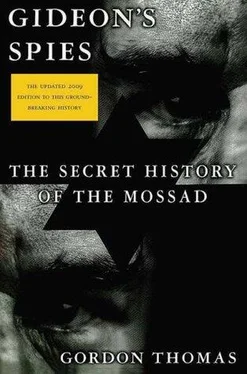Gordon Thomas - Gideon's Spies
Здесь есть возможность читать онлайн «Gordon Thomas - Gideon's Spies» весь текст электронной книги совершенно бесплатно (целиком полную версию без сокращений). В некоторых случаях можно слушать аудио, скачать через торрент в формате fb2 и присутствует краткое содержание. Город: New York, Год выпуска: 2009, ISBN: 2009, Издательство: Thomas Dunne Books, Жанр: История, на английском языке. Описание произведения, (предисловие) а так же отзывы посетителей доступны на портале библиотеки ЛибКат.
- Название:Gideon's Spies
- Автор:
- Издательство:Thomas Dunne Books
- Жанр:
- Год:2009
- Город:New York
- ISBN:978-0-312-53901-6
- Рейтинг книги:4 / 5. Голосов: 1
-
Избранное:Добавить в избранное
- Отзывы:
-
Ваша оценка:
- 80
- 1
- 2
- 3
- 4
- 5
Gideon's Spies: краткое содержание, описание и аннотация
Предлагаем к чтению аннотацию, описание, краткое содержание или предисловие (зависит от того, что написал сам автор книги «Gideon's Spies»). Если вы не нашли необходимую информацию о книге — напишите в комментариях, мы постараемся отыскать её.
Gideon’s Spies
Gideon's Spies — читать онлайн бесплатно полную книгу (весь текст) целиком
Ниже представлен текст книги, разбитый по страницам. Система сохранения места последней прочитанной страницы, позволяет с удобством читать онлайн бесплатно книгу «Gideon's Spies», без необходимости каждый раз заново искать на чём Вы остановились. Поставьте закладку, и сможете в любой момент перейти на страницу, на которой закончили чтение.
Интервал:
Закладка:
Efraim Halevy knew that was the weakness in the American system: any list was only as good as the analysts who put a person’s name on it. And that, he had politely told Tenet in that phone call, was where the Americans had failed.
Tenet was furious. He was wedded to the wonders of electronic surveillance. For him, it was the ultimate billion-dollar instrument of superpower espionage. The sentinels in space, the high-tech spy satellites with exotic-sounding names like Argus, Magnum, and Keyhole, were how Washington—and in many ways Tenet himself as the head of its intelligence community—kept track of the rest of the world. On his own visits to Israel, he had shown Halevy how, out in the icy blackness of outer space, a satellite pointed down on Yasser Arafat’s headquarters on the West Bank had picked up his conversations. Halevy, so the story went, had smiled politely. But what had Arafat been saying that justified the expense of all that surveillance? Tenet had shrugged.
Halevy had studied the satellite photo for a moment longer, noting the date. Then he had asked one of his analysts to fetch a report on the same day. It was a detailed account from a Mossad katsa of what Arafat had said when the satellite had passed overhead. Halevy had murmured that that was the point of human intelligence. A spy on the ground could judge a conversation in its setting, obtain the finer details that are lost to even the most sophisticated electronic surveillance.
At his next meeting with President George W. Bush, the CIA chief had complained that “the old man in Tel Aviv is outta touch.” Bush had discussed the matter with Condoleezza Rice, his closest adviser. She said she would speak to Dick Clarke, who had been President Clinton’s counterterrorism “czar.” Few people in Washington had worked for longer in the field.
The son of a Boston chocolate factory worker, Clarke was a survivor of the American politico-military establishment. For successive administrations, from President Reagan onward, he had become a source of endless advice. He saw himself as a defender of American values.
Despite his enemies, people listened to him. Privately they may have mocked the way Clarke strove to look like the latest incumbent in the White House—he had even dyed his hair silver when Clinton was in office, so they said—but he was the man who knew the standing of every intelligence chief in the West, and of many in China and Arab countries. He told Rice that Halevy was “past his sell-by date.” She told Bush. He called Sharon. It was only a matter of time before Israel’s prime minister would find a reason to send Halevy into retirement.
The men and women making their way through Mossad’s corridors knew, if not all, then part of this. Some of their colleagues had already left Mossad, either resigning or being driven out by a feeling that there was no real future in the organization. For them it was no longer enough to create situations that sought to draw fact out of surmise, to spend their days applying the art of informed conjecture and dealing in the middle range of probability. Others had stayed on in the hope that one day things would change—that there would, for instance, be no repetition of an operation for which Efraim Halevy would forever be remembered in these corridors.
On May 9, 2001, two young men drove up to the guard post at Volk Field in Wisconsin, one of several air bases the Air National Guard maintains across the country. Volk Field has another claim of interest. Within its perimeter is a small aeronautical museum. Every year from spring until September, a steady stream of visitors comes to inspect the display of aircraft.
The guard asked the men for their IDs, and was surprised when they produced Israeli passports. He could not recall visitors coming from so far. They explained they were “art students” at the “University of Jerusalem.”
As with all visitors, the guard noted down their names—Gal Kantor and Tsvi Watermann—then directed them to the museum. Ten minutes later a military police patrol caught them taking photographs of parked fighter planes. The men were arrested but pleaded that they had not known they were committing an offense. The base duty security officer released them with a warning. His report of the incident made its way through the Wisconsin military command structure and on to the Pentagon.
From there it was sent to the FBI. On that May day, the bureau had already received twenty-seven other reports involving Israeli “art students.” The reports came from as far apart as Los Angeles and Miami, Denver and Dallas, Seattle and New Orleans.
The details were remarkable in their consistency. Two “art students” in St Louis had been caught “diagramming the inside of a Drug Enforcement Agency building.” In another federal building in Dallas, another pair had been stopped doing the same thing. In several cities, other “art students” had shown up at the homes of senior federal officials—men with unlisted addresses, known as “black addresses” in the U.S. intelligence community. In other cities—Phoenix and San Diego were two—the “students” had been found in possession of photographs of federal agents and their unmarked cars. All the reports said that the students had given their address as the “University of Jerusalem” or the “Bezalei Academy of Arts” in the city.
The FBI had asked the State Department to have the United States embassy in Israel run a check. It reported that no “University of Jerusalem” existed. The nearest was the city’s Hebrew University, and it had no record of the “students.” The Bezalei Academy was genuine. But the dates of birth, passport numbers, and in some cases military registration numbers of the “art students” were not listed on the academy’s enrollment list, or lists of those who had attended up to ten years before. While this information was being obtained, FBI agents in Washington had traced the cell phones the mysterious “students” were carrying. All had been purchased by an Israeli diplomat in Washington who had now returned to Israel.
The news caused consternation in FBI headquarters. Robert Mueller, then the bureau’s director, called for a meeting with George Tenet. Uppermost in their minds was whether they were facing another spying operation by Mossad. But would an agency that had made its name for unrivaled planning and stealth have mounted one that, on the surface at least, was so amateurish?
Tenet placed a call to Halevy, who denied that any operation was going on.
He was lying. The operation had been his brainchild. Stung by the refusal—and this was months before the September 11 attacks—to take heed of Mossad’s warnings that al-Qaeda was a growing threat within the United States, Halevy had decided to test how vigilant were American defenses. Students from their final year at the Mossad training school on the outskirts of Tel Aviv had been selected to go to America. It would not be the first time that Mossad had used its students for this purpose; it gave them valuable field experience, and anything they acquired could be useful to Mossad.
Halevy had chosen to run the operation with only a few Mossad staff involved. Again, it was not uncommon for a director general to do this. But what made it unusual was that the preplanning and cover stories were a disaster waiting to happen. Just as at Lillehammer and on the streets of Amman—both debacles that had cost Halevy’s predecessors their jobs—there was an element of recklessness about what the “art students” had been briefed to do that baffled the FBI. Surely, Mossad could not have slipped so far, to be running something like this?
As the FBI began its investigation, the inevitable happened: the news leaked. Soon a number of reporters were trying to pin down the story. Much of their initial reporting was wide of the mark. The “art students” were described as “Middle Easterners” and “speaking Arabic.” They were identified as members of an unnamed terrorist group.
Читать дальшеИнтервал:
Закладка:
Похожие книги на «Gideon's Spies»
Представляем Вашему вниманию похожие книги на «Gideon's Spies» списком для выбора. Мы отобрали схожую по названию и смыслу литературу в надежде предоставить читателям больше вариантов отыскать новые, интересные, ещё непрочитанные произведения.
Обсуждение, отзывы о книге «Gideon's Spies» и просто собственные мнения читателей. Оставьте ваши комментарии, напишите, что Вы думаете о произведении, его смысле или главных героях. Укажите что конкретно понравилось, а что нет, и почему Вы так считаете.












